
It seems insane that in a country as big as Australia – with a large appetite for four-wheel drive vehicles and miles of unsealed roads – that there has never been a mass-produced 4x4 wagon built here.
Who knows, if Ford and Holden had designed and built home-grown 4x4s 20 years ago, they might still be in a position to be making cars here instead of shutting up shop.
Something we can do here and do well is design and engineer cars, and the Everest from Ford is the latest vehicle with roots in Victoria. A continuation of the T6 development, which first spawned the Ford PX Ranger and Mazda BT-50 utes, the Everest is a seven-seat wagon riding on a modified T6 platform. It is built in Thailand along with the Ranger ute.
 By modified T6 platform, we mean everything from under the front seats rearwards is new, including the shortened wheelbase (in relation to Ranger) and rear suspension design. We say new as it’s new to T6, but the rear end uses a live axle with coil springs, trailing arms and a Watts link – a design tried and tested in Ford passenger cars for years and well-adapted to the Everest. It works well with the independent coil-sprung front end.
By modified T6 platform, we mean everything from under the front seats rearwards is new, including the shortened wheelbase (in relation to Ranger) and rear suspension design. We say new as it’s new to T6, but the rear end uses a live axle with coil springs, trailing arms and a Watts link – a design tried and tested in Ford passenger cars for years and well-adapted to the Everest. It works well with the independent coil-sprung front end.
TOURING
Like Australian-made station wagons of yore, the Everest is a supreme tourer. The torquey 3.2-litre, five-cylinder diesel engine lopes along at a relaxed pace but keeps plenty of muscle tucked up its sleeves for when it’s needed. The tweaks Ford has made to the engine for the Everest and upgraded PXII Ranger give it more usable grunt – even though the numbers are no higher – while at the same time it’s quieter and more refined.
Clever tuning of the fuel system and a smaller turbocharger are to thank for that.
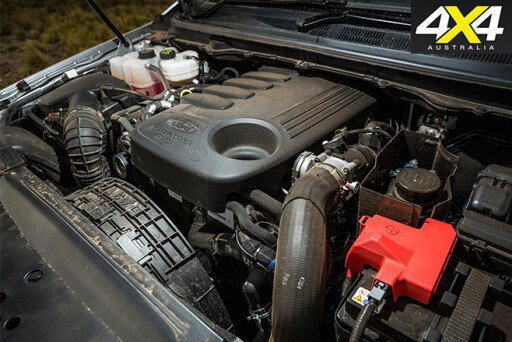 The aforementioned suspension soaks up road bumps, yet it’s relatively taught and nimble when compared to other 4x4 wagons in this segment. The Everest is no sports car, but it feels like it when you step out of some of the other wagons.
The aforementioned suspension soaks up road bumps, yet it’s relatively taught and nimble when compared to other 4x4 wagons in this segment. The Everest is no sports car, but it feels like it when you step out of some of the other wagons.
The Everest has an 80-litre fuel tank and an ADR combined fuel figure of 8.5L/100km. On this 4X4OTY test it was the thirstiest vehicle, gulping down a hefty 13.0L/100km over the on and off-road trial.
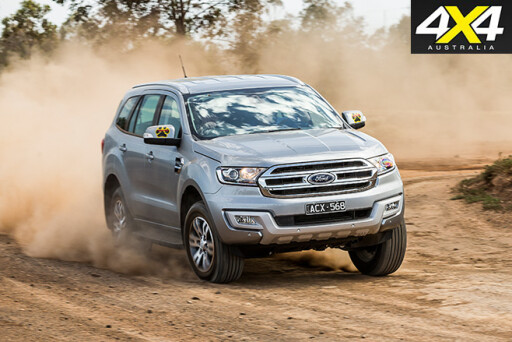 The Everest also uses AdBlue to help clean up its emissions, which is stored in an 18-litre tank at the rear of the car. Under normal driving conditions those 18 litres should be good for between 12,000km to 16,000km, so you shouldn’t need to worry about it. Drivers doing big mileage or heavy towing may want to carry a top-up bottle of the urea with them.
The Everest also uses AdBlue to help clean up its emissions, which is stored in an 18-litre tank at the rear of the car. Under normal driving conditions those 18 litres should be good for between 12,000km to 16,000km, so you shouldn’t need to worry about it. Drivers doing big mileage or heavy towing may want to carry a top-up bottle of the urea with them.
TRAIL DRIVING
The Everest feels just as at home running the tracks of the Victorian High Country as it does on the open roads. The view over the big bonnet is good and the driver’s seat has plenty of adjustment for different drivers. Unfortunately, though, there is no reach adjustment on the steering column.
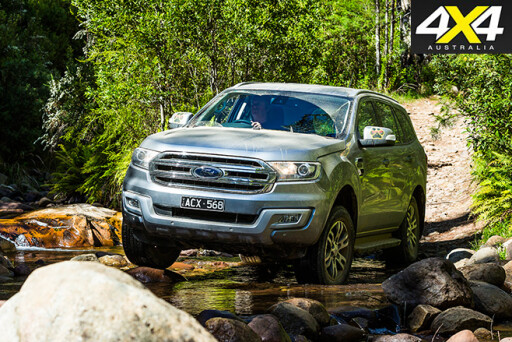 The powerful engine requires little throttle on all but the steepest climbs, and the automatic transmission continues its fine job of holding the right gears for the steep descents. There’s manual selection via the floor shifter but no column paddles. The suspension still feels firm on the rough stuff, but it’s never uncomfortable.
The powerful engine requires little throttle on all but the steepest climbs, and the automatic transmission continues its fine job of holding the right gears for the steep descents. There’s manual selection via the floor shifter but no column paddles. The suspension still feels firm on the rough stuff, but it’s never uncomfortable.
SET-PIECE HILL CLIMB
With its Multi Terrain Selector left in ‘normal’ mode, low range selected in the transfer case, ‘Drive’ nominated in the transmission and the rear diff lock (RDL)engaged, the Ford didn’t raise a sweat climbing our steep and rutted hill, and its electronic descent control offered a smooth and seamless ride downhill.
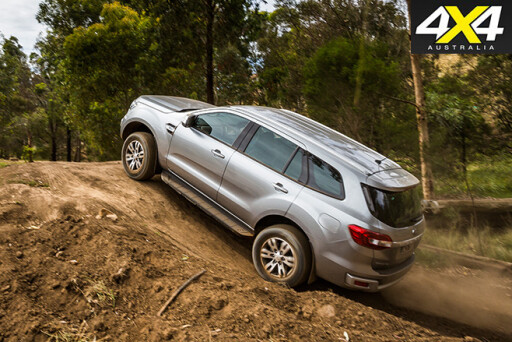 It wasn’t so successful without the RDL engaged and couldn’t drive up the same line without losing traction. With the RDL in, the Ford keeps its electronic traction control active on the front axle, which is the key to its success here.
It wasn’t so successful without the RDL engaged and couldn’t drive up the same line without losing traction. With the RDL in, the Ford keeps its electronic traction control active on the front axle, which is the key to its success here.
The Everest had no clearance issues.
CABIN, EQUIPMENT AND ACCOMMODATION
The Everest is only offered as a three-row seven-seater, and it fills that role well. The rearmost seats will accommodate children and adults for shorter rides, while the other seats are big and roomy. The third row is a bit awkward to access, but not as bad as some we’ve tested. Both it and the second row fold flat to give a handy cargo area or somewhere you could lay a mattress over to sleep on in camp.
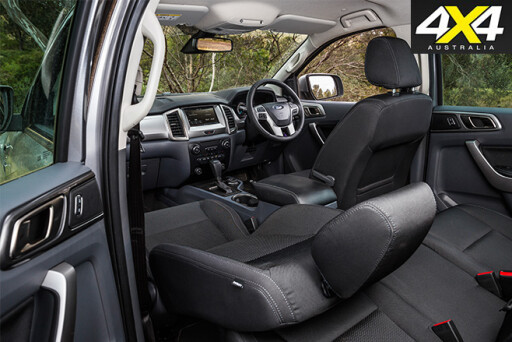 The Everest is well-equipped with standard features including multiple 12-volt and USB power outlets, a 230-volt power outlet, air-con vents right to the back of the car and dual-zone climate control up front. About the only complaint we have about the Everest’s cabin are the small, fiddly buttons that control the HVAC and how low they are placed in the centre stack. All our drivers appreciated the big-car feel of the Ford cabin.
The Everest is well-equipped with standard features including multiple 12-volt and USB power outlets, a 230-volt power outlet, air-con vents right to the back of the car and dual-zone climate control up front. About the only complaint we have about the Everest’s cabin are the small, fiddly buttons that control the HVAC and how low they are placed in the centre stack. All our drivers appreciated the big-car feel of the Ford cabin.
PRACTICALITIES
The 265/60-18 tyre size, as fitted to the Everest Trend, is becoming more common, so there should be reasonable tyre choices available and access to spares in remote areas. Alternatively, you can fit the 17-inch wheels from the base model and open up the next level of choices. The Everest has a full-size matching spare hanging under the back.
Under the bonnet, the engine breathes from over the headlight but via the grille, so it’s not a bad set-up. The air cleaner is large and can be serviced without needing tools. The engine bay is pretty busy, so you’ll have to find somewhere else for an auxiliary battery or powerpack.
 If the position of air intake poses a potential problem for you, Ford offers an accessory snorkel among its extensive range of factory options, which includes bullbars and a luggage carrying kit.
If the position of air intake poses a potential problem for you, Ford offers an accessory snorkel among its extensive range of factory options, which includes bullbars and a luggage carrying kit.
Expecting it to be a popular model, the aftermarket accessory regulars are hard at work producing their catalogues for the Everest, too.
SUMMARY
The Ford Everest is an exciting new player in the 4x4 wagon segment. It does everything it claims to and does it well; be that ferrying the family, taking on rough and tough terrain or riding with refined comfort.
It brings leading safety and crash-avoidance technology down to a price point not seen before in this segment, making it more accessible to more buyers. It might not be manufactured here, but we should be proud of what Ford Australia has done with the Everest.
 As 4X4OTY judge Dean Mellor commented, it has “loads of equipment in a tough package that has obviously been engineered for local Australian conditions”.
As 4X4OTY judge Dean Mellor commented, it has “loads of equipment in a tough package that has obviously been engineered for local Australian conditions”.
SPECS
Engine: DOHC 20-valve 5-cyl diesel
Capacity: 3.2-litre (3198cc)
Power: 143kW @ 3000rpm
Torque: 470Nm @ 1750-2500rpm
Gearbox: 6-speed auto
4X4 System: Full-time dual-range
Crawl Ratio: 38.6:1
Construction: separate chassis
Front suspension: independent/coil springs
Rear suspension: live axle/coil springs
Wheel/tyre spec: 265/60R18 110T
Kerb Mass: 2407kg
GVM: 3100kg
Payload: 693kg
Towing Capacity: 3000kg
Seating capacity: seven
Fuel tank capacity: 80 litres
ADR fuel claim: 8.5L/100km
On-test consumption: 13.0L/100km
Touring range*: 719km
Price: $60,990 (auto only)
*Based on test consumption and 50km ‘safety margin’.
MORE 4X4 OF THE YEAR
 HOME: 4X4 OF THE YEAR 2016
HOME: 4X4 OF THE YEAR 2016
On the shortlist for 4X4OTY 2016 were the Hilux, Triton, Fortuner, Prado, Navara and Everest.
 THE FINALISTS
THE FINALISTS
The six best 4x4 vehicles of 2015 battling it out to be crowned 4x4 Of The Year 2016.
 THE RESULTS
THE RESULTS
Only one of the six best 4x4s from 2015 can be crowned 4x4 Of The Year 2016
 4X4 OF THE YEAR HOME
4X4 OF THE YEAR HOME
Finding Australia's Best 4x4s

COMMENTS